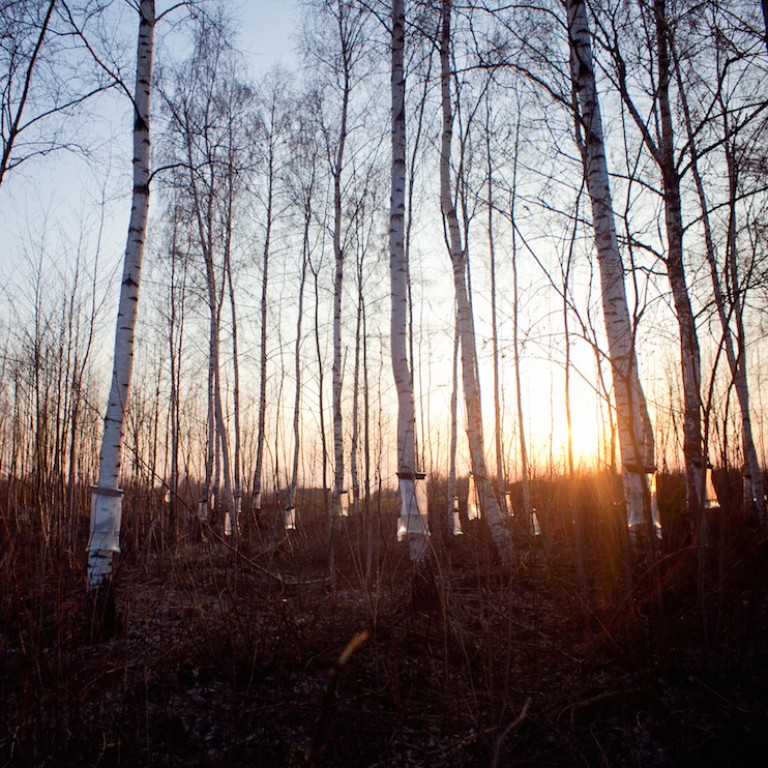
Birch water becoming the latest wonder drink for the health obsessed
Birch sap, long consumed in parts of Europe and northern China and claimed to have many benefits, is fast turning into a global phenomenon, and is now on sale in Hong Kong
Still sipping on coconut water? Oh, that’s as yesterday as the Kardashians. There’s a new wonder drink in town that boasts a bounty of health benefits with just a quarter of the calories.
Birch water – which is really the sap tapped from birch trees – claims to restore vitality, boost immunity, detoxify the body, fight fatigue, relieve joint pain, eliminate cellulite, alleviate skin conditions and treat ailments such as flu, headaches, bronchitis and liver disease.
“Birch sap is an invaluable remedy for rheumatic diseases, the after-effects of gout, bladder obstructions, and countless chronic ills,” according to Baron Pierre-Francois Percy (1754-1825), army surgeon and inspector general to Napoleon.
Demand is coming from people looking for alternatives to soda
For sports, birch sap has been tested in Olympic athletes by the All-Russian Research Institute of Physical Culture and Sport. The institute, which analysed birch sap from Finland’s Nordic Koivu, the world’s leading birch sap producer, recommends the drink for optimising the functional state of the body during training and competition, and for accelerating recovery and preventing metabolic disorders and cardiovascular diseases.
It also has beauty benefits. When used in skincare products, birch sap is said to purify the skin, help restore skin tone and radiance, boost hydration and promote cell renewal, and revitalise the skin and improve its elasticity.

Birch water, which in the past year has been a hot commodity among the health-obsessed in Britain and the US, made its Hong Kong debut in June when local company Raleigh Sterling started importing Sibberi Birch Water. Fitness-oriented women and the yoga community have formed the bulk of customers, according to Christine Jagolino of Raleigh Sterling.
“[Drinking birch water] is the fashionable thing to do now,” says Jagolino. “It’s part of a new category of alternative ‘water’. Demand is coming from people looking for alternatives to soda.”
Birch water contains just 5 calories per 100 millilitres, compared to 20 calories in coconut water and more than 40 calories in cola.
For centuries, people in Eastern Europe, Russia, Scandinavia and parts of northern China have been enjoying the beverage during the transition between winter and spring, when the snow melts and the first leaves emerge.
In these communities, birch sap is also a traditional medicine used to promote the body’s elimination functions. In the 16th century, the birch tree was called the “nephritic tree of Europe”.
In autumn, birch trees accumulate natural nutrients and vitamins which are then stored in their roots during winter. In spring, warmth triggers the roots to draw spring water from the ground up into the trunk and to the branches, taking the stored nutrients with it. This sap flows for only about two to three weeks before the burst of first leaves.
A hole is drilled into the birch tree and a spout inserted to collect the sap. It can be drunk fresh or boiled down to make syrup. It keeps for up to six days in the refrigerator, or can be frozen for future use.
Pasteurisation technology, however, has enabled birch water to be packaged and drunk year-round and worldwide. Many birch water brands have sprung up recently, tapping into trees from various locations, such as BelSeva (tapped from trees in a tiny village Nant-le-Petit in Lorraine, northeast France), Byarozavik (from Belarus), TreeVitalise (from Eastern Europe’s Carpathian Mountains) and Sealand Birk (from Finland).

Sibberi comes from trees in Latvia. Only 1 per cent of the sap is drawn, says Jagolino, so that the trees’ natural processes are not disrupted. It costs about HK$40 per 300ml bottle, and is sold online at Berrytime (berrytime.com) and Life Project (lifeproject.hk), and in stores at Cabinet Organic in Sai Ying Pun and Food for Life.
“Some people say it tastes like yogurt. Others say it’s citrusy or like apple cider vinegar. Still others say it reminds them of coconut water or sugar cane,” says Jagolino.
I had my first swig of birch water at Sibberi’s booth at last week’s Natural & Organic Products Asia expo. Compared to coconut water, it looks and has a mouth-feel more like plain water, and definitely has a much subtler flavour. The aftertaste is slightly sourish and fermented.
While the drink may be a healthier alternative to soda, there isn’t really any solid scientific evidence to back its multitude of health claims.
Sibberi co-founder Clara Vaisse says she’d rather let the product’s inherent nutrients speak for themselves. Birch water is packed with electrolytes and micronutrients such as saponin, xylitol and betuloside.
Saponins are phytochemicals that studies show can have a beneficial effect on blood cholesterol levels, cancer, bone health and the stimulation of the immune system.
Xylitol, a naturally occurring alcohol, is often added to oral care products to prevent tooth decay and dry mouth.
Betuloside has been shown to have analgesic, anti-inflammatory and diuretic properties, which aid in flushing out toxins and in weight loss.
Finland native Mikko Revonniemi, founder of Berrytime, warns that some birch water brands add sweeteners and other chemicals to the natural product. These brands, he says, are “basically soda with high marketing value”.
Revonniemi has been drinking birch water since he was five. Collecting birch water was an annual activity with his father.
“There is something magical about going into the woods, collecting some birch water and enjoying it immediately,” he says. “That magic disappears the moment it’s pasteurised, bottled and shipped to the other side of the world.”

